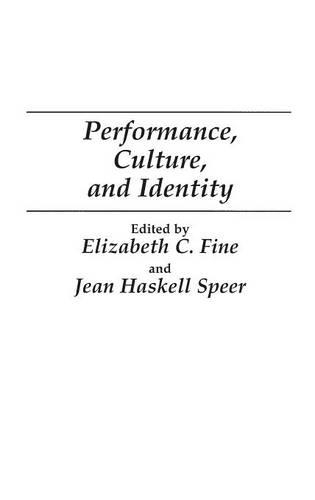
Performance, Culture, and Identity
(Hardback)
Publishing Details
Performance, Culture, and Identity
By (Author) Elizabeth C. Fine
By (author) Jean Haskell
Bloomsbury Publishing PLC
Praeger Publishers Inc
20th October 1992
United States
Classifications
Tertiary Education
Non Fiction
Folklore studies / Study of myth
Cultural studies
302.2
Physical Properties
Hardback
320
Description
"Performance, culture and identity" is based on the premise that artistic performance is epistemological, a way of knowing self, culture and other. The nine essays share a common interest in exploring how performance reveals, shapes, and sometimes transforms personal and cultural identity. The editors begin by examining the interdisciplinary roots of performance studies and their role in the field of communication. They draw on concepts from Victor Turner, Richard Schechner, Richard Bauman, Aristotle, Kenneth Burke, Peter Berger and Thomas Luckmann, Barbara Myerhoff and others. They explain the power of performance to shape identity. Their introduction discusses the significant issues in performance studies that cut across many of the essays to follow, such as the politics of culture, cultural hegemony, the influence of a sense of place on cultural identity, and the moral dimension of performance. The first two studies explore the ritual nature of performance in two different cultural contexts: the sacred space of a church service and the secular space of a storytelling event. In both arenas, the performers act as "shamans", transporting the audience from their everyday lives to the "higher ground" of heroic and fantastic events. The next three essays discuss the notion of place and performance in various landscapes - the English countryside, the hills of Appalachia, and the farmland of the Midwest. In all three locations, the performers comment on the changes that have affected their identity with the land. The last four chapters focus on women as storytellers. In one, the contributors show how "spinstorying" creates a group identity which challenges the male-dominated discourse that tends to particularise, depreciate, regulate, and silence women's identity. Another chapter interprets a deceptively simple narration of a Galician women's "typical day". The next examines Hmong (Thai) storycloths as intercultural and dialogical performances. The last chapter explores identity and meaning in the storytelling of a woman in the last years of her life.
Reviews
This book contains some excellent examples of new fields of narrative performance, like, for example, a storyteller as shamon, failure on the farm as performance, spinstorying as women storytelling and autobiographing as creation of the ultimate self.-Journal of Popular Culture
"This book contains some excellent examples of new fields of narrative performance, like, for example, a storyteller as shamon, failure on the farm as performance, spinstorying as women storytelling and autobiographing as creation of the ultimate self."-Journal of Popular Culture
Author Bio
ELIZABETH C. FINE is Associate Professor at Virginia Polytechnic State University, where she holds a joint appointment in Communication Studies and the Center for Programs in the Humanities. She has written many works on performance, including The Folklore Text: From Performance to Print, which was a 1985 Choice Outstanding Academic Book and winner of a Chicago Folklore Prize. She has served as chair of the Performance Studies Division of the Speech Communication Association. JEAN HASKELL SPEER is Associate Professor of Communication Studies at Virginia Polytechnic State University, holding a joint appointment in Communication Studies and the Center for Programs in the Humanities. She is published widely in performance studies and Appalachian studies, and is the author of The Appalachian Photographs of Earl Palmer. Speer has served as chair of the Performance Studies Division of the Speech Communication Association and as president of the Virginia Folkore Society. Currently, she is Cultural Resource Advisor to the Blue Ridge Parkway and a member of the design team planning a traditional music interpretive center on the parkway.
